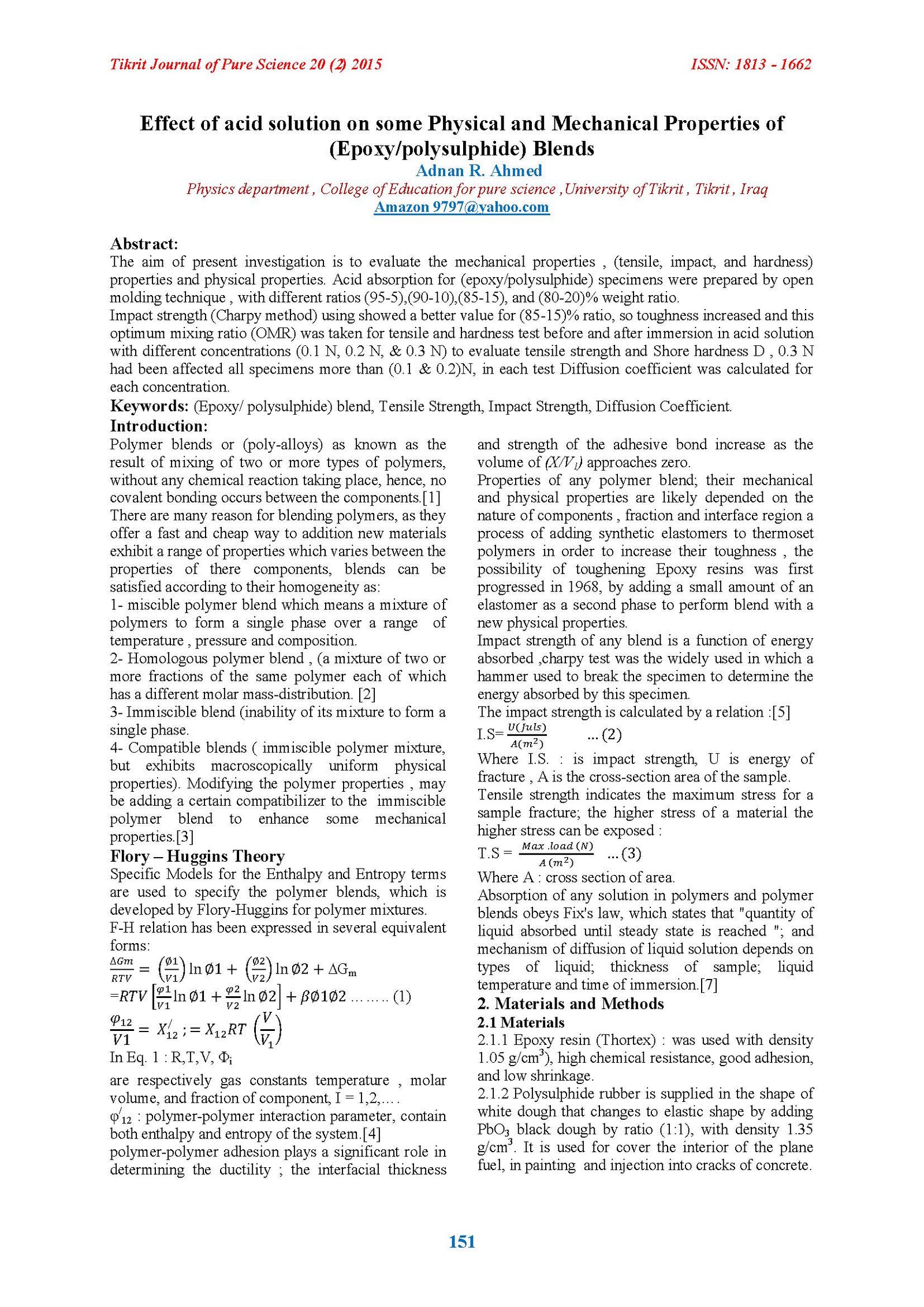Effect of acid solution on some Physical and Mechanical Properties of (Epoxy/polysulphide) Blends
Main Article Content
Abstract
The aim of present investigation is to evaluate the mechanical properties , (tensile, impact, and hardness) properties and physical properties. Acid absorption for (epoxy/polysulphide) specimens were prepared by open molding technique , with different ratios (95-5),(90-10),(85-15), and (80-20)% weight ratio.
Impact strength (Charpy method) using showed a better value for (85-15)% ratio, so toughness increased and this optimum mixing ratio (OMR) was taken for tensile and hardness test before and after immersion in acid solution with different concentrations (0.1 N, 0.2 N, & 0.3 N) to evaluate tensile strength and Shore hardness D , 0.3 N had been affected all specimens more than (0.1 & 0.2)N, in each test Diffusion coefficient was calculated for each concentration.
Article Details

This work is licensed under a Creative Commons Attribution 4.0 International License.
Tikrit Journal of Pure Science is licensed under the Creative Commons Attribution 4.0 International License, which allows users to copy, create extracts, abstracts, and new works from the article, alter and revise the article, and make commercial use of the article (including reuse and/or resale of the article by commercial entities), provided the user gives appropriate credit (with a link to the formal publication through the relevant DOI), provides a link to the license, indicates if changes were made, and the licensor is not represented as endorsing the use made of the work. The authors hold the copyright for their published work on the Tikrit J. Pure Sci. website, while Tikrit J. Pure Sci. is responsible for appreciate citation of their work, which is released under CC-BY-4.0, enabling the unrestricted use, distribution, and reproduction of an article in any medium, provided that the original work is properly cited.
References
1. Robeson, L., M., "Polymer blends Handbook", Klwer Academic Publish, Netherland, 2003.
2. Leszek, A., "Polymer Alloy and Blends, Thermodynamics and Rheology ", Hanser Pub., 1989.
3. Work, W., J., Horie, & K. Hess, " Polymer Blends Diffusion", interaction Vuion of Pure and applied chemistry, vol. 76, No.11, P.P 1985-2007. 2004
4. Utracki, L. A., "Polymer Blends Handbook", vol.1, klwer academic pub. , Netherlands. 2003
5. La Faro, Carmelo and Cicala, Gianluca, "The Energy Absorption of Engineering Materials", cytec Engineered Materials , United Kingdom. 2002
6. ASTM D 638.
7. AL-Azzawi, Ali Hassan R., " The Effect of some Solutions on the Physical Properties of particulates Composites", Ph.D. Thesis, Dep. Of App. Sci., University of Technology. 2008
8. Balkees M. Dheya, "Effect of Aggressive Solutions on the Impact Behavior of Fiber Reinforced Epoxy Resin", International Conference on Engineering and Information Technology" Sep. 17-18, Toronto, Canada, PP 127-130. 2012
9. Thomas, S. ,Aprem, A., S., " Applied Polymer Sciences ", vol. 78, PP. 941-952. 2000
10 .Balkees M. Dheya& Ahmed S., " Study of the Environmental Affect on Creep Test of PE. Blends", International Congress on Advances in Applied Physics and Materials Sci. .Alp conf. proc.1400, 227-231. 2011
11. Schaffer J. P., Saxena, A. Antolorich; "The Science and design of Engineering Materials", Richardson D. Irwin, Inc.1995
12. J. Bhaskar, V. K. Sigh; " Water Absorption and Compressive Properties of Coconut Shell Practical Reinforced Epoxy Composite", J. Mat. Environment Sciences, vol. 4, No. 1 , pp 113-118. ISSN:2028-2508. 2013
